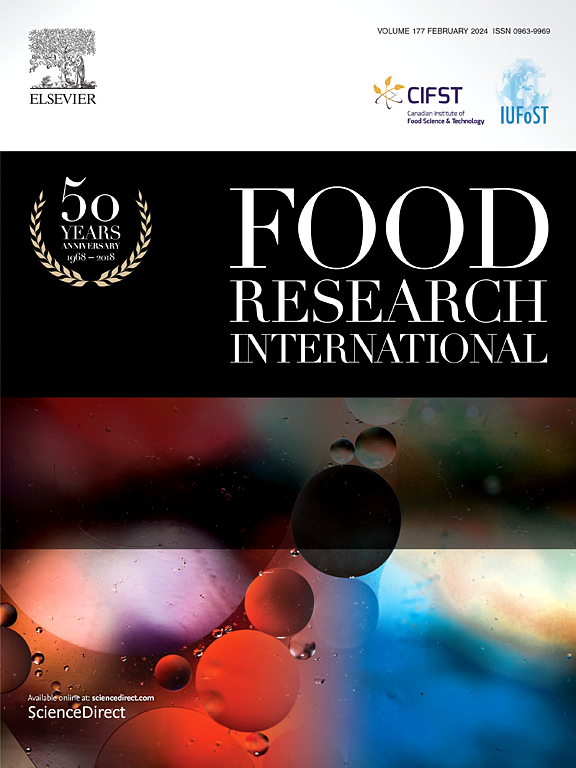Hypothermal effects of cold anesthesia on the vitality and muscle quality of live Chinese mitten crab (Eriocheir sinensis)
IF 7
1区 农林科学
Q1 FOOD SCIENCE & TECHNOLOGY
引用次数: 0
Abstract
Crab encounters obstacles like elevated transportation expense and diminished survival rate. In the study, the effects of cold anesthesia (CA), including fast cooling (FC) and slow cooling (SC) anesthesia on the vitality state and muscle quality of Chinese mitten crab were researched. We found firstly that the CA dormancy temperature range of Chinese mitten crab was identified from −2 to 10 °C, and 7 °C was optimal. They could survive for a duration of 10 d when subjected at 7 °C, the survival rate of SC treatment significantly increased to 80.6 %. Compared with the control and FC groups, the Lt50 of crab in the SC group was prolonged, and the mass loss rate, lactic acid content, and oxidative loss of myofibrillar protein (MP) were significantly increased during storage. Moreover, the texture became soft, the myofibrillar structure was broken, the gaps between muscle fibers were enlarged, and the water-holding capacity (WHC) decreased significantly in the control group, while the texture and WHC in CA treatments (FC and SC) had no significant change, especially SC. CA treatments could effectively prevent myofibril destruction, reduce pH fluctuation and protein oxidation, and keep fixed water in the muscle. Of the two CA treatments, SC was more conducive to maintaining muscle quality and vital signs. Therefore, CA treatments not only enhanced survival rate but also inhibited muscle deterioration, especially SC. These findings offered crucial empirical support for advancements in live crab preservation technology and should be validated on a larger scale.

低温麻醉对中华绒螯蟹活蟹活力和肌肉品质的影响
螃蟹遇到了运输费用增加、存活率降低等障碍。本研究研究了冷麻醉(CA),包括快冷麻醉(FC)和慢冷麻醉(SC)对中华绒螯蟹活力状态和肌肉品质的影响。首先,中华绒螯蟹CA的休眠温度范围为- 2 ~ 10℃,其中7℃为最佳;在7℃条件下可存活10 d, SC处理的存活率显著提高至80.6%。与对照组和FC组相比,SC组延长了蟹的Lt50,显著提高了蟹在贮藏过程中的质量损失率、乳酸含量和肌原纤维蛋白(MP)的氧化损失。对照组肌理变软,肌纤维结构断裂,肌纤维间隙增大,持水能力(WHC)显著下降,而CA处理(FC和SC)的肌理和持水能力(WHC)变化不显著,特别是SC处理能有效防止肌原纤维破坏,降低pH波动和蛋白质氧化,保持肌肉中固定水分。在两种CA处理中,SC更有利于维持肌肉质量和生命体征。因此,CA处理不仅提高了存活率,而且还抑制了肌肉退化,尤其是SC。这些发现为活蟹保存技术的进步提供了重要的经验支持,应该在更大规模的实验中得到验证。
本文章由计算机程序翻译,如有差异,请以英文原文为准。
求助全文
约1分钟内获得全文
求助全文
来源期刊

Food Research International
工程技术-食品科技
CiteScore
12.50
自引率
7.40%
发文量
1183
审稿时长
79 days
期刊介绍:
Food Research International serves as a rapid dissemination platform for significant and impactful research in food science, technology, engineering, and nutrition. The journal focuses on publishing novel, high-quality, and high-impact review papers, original research papers, and letters to the editors across various disciplines in the science and technology of food. Additionally, it follows a policy of publishing special issues on topical and emergent subjects in food research or related areas. Selected, peer-reviewed papers from scientific meetings, workshops, and conferences on the science, technology, and engineering of foods are also featured in special issues.
 求助内容:
求助内容: 应助结果提醒方式:
应助结果提醒方式:


